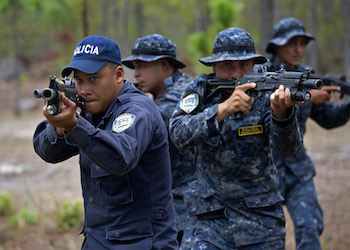Authorities in Honduras say that their fight against organized crime is responsible for the country’s plateauing homicide rate, highlighting the complex interaction between hard-line security policies and levels of violence.*
In years past, Honduras has been the murder capital of the world. Homicides peaked in 2011 at a rate of 86.5 murders per 100,000 people. However, that rate has dropped considerably since, El Heraldo reported.
According to figures from the Violence Observatory at the National Autonomous University of Honduras (Universidad Nacional Autónoma de Honduras – UNAH), homicides fell slightly to a rate of 85.5 per 100,000 in 2012, and slightly more in 2013 to 79 per 100,000.
The homicide rate saw its biggest drop between 2013 and 2014, during which murders fell to a rate of 68 per 100,000. This decrease continued through 2015 as the year-end homicide rate rounded out at 60 per 100,000.
However, this steady decrease leveled out in 2016 as the homicide rate remained almost identical. The Violence Observatory at UNAH recorded 5,154 homicides in 2016, just six more than the 5,148 homicides recorded in 2015.
In reference to the minimal reduction in 2016, Honduran Police Chief Felix Villanueva told El Heraldo that in 2016 there was a “direct attack on the criminal structures” that caused homicide rates to stagnate as criminal groups “retaliated” against the hardline measures.
Last month after an official visit to Washington, Honduran President Juan Orlando Hernández explained how the United States praised Honduras as an example of “security, transparency, fighting corruption and impunity,” among other things.
However, the 2016 annual report from the United Nations High Commissioner for Human Rights stressed that “violence and crime persist in Honduras due to a complex set of historical and contextual factors.”
InSight Crime Analysis
Accounting for changes in countries’ homicide rates is a complex process, and there are always factors to consider beyond the government’s security strategy. However, Honduran authorities appear to be making contradictory assumptions about the effects of their anti-crime strategies.
On one hand, Villanueva claims that the government’s forceful efforts to combat crime have led to a response from criminal groups that has led to the end of the general trend of declining violence seen in recent years. But President Hernández has in the past appeared to credit his government’s heavy-handed approach for improvements in security.
It is unlikely that either explanation is entirely accurate. Moreover, Hernández’s praise of Honduran security forces comes as he mounts a run for re-election after the Supreme Court overturned the constitutional ban on the practice in 2015. Linking his administration’s policies to the general decline in violence in recent years might be an effort to strengthen that bid.
SEE MORE: Honduras News and Profile
The police too may be trying to frame statistics in a positive light. Rather than explaining the plateau in murder rates as a potential sign of the limits of repressive approaches to crime, the police are spinning it as evidence that crime groups are hurting due to their efforts.
It is important to note that highlighting homicide statistics may play well politically, but narrowly focusing on murder rates ignores other indicators of criminality, potentially leaving important security problems unaddressed.
* This article has been updated from its original version to clarify several points.

